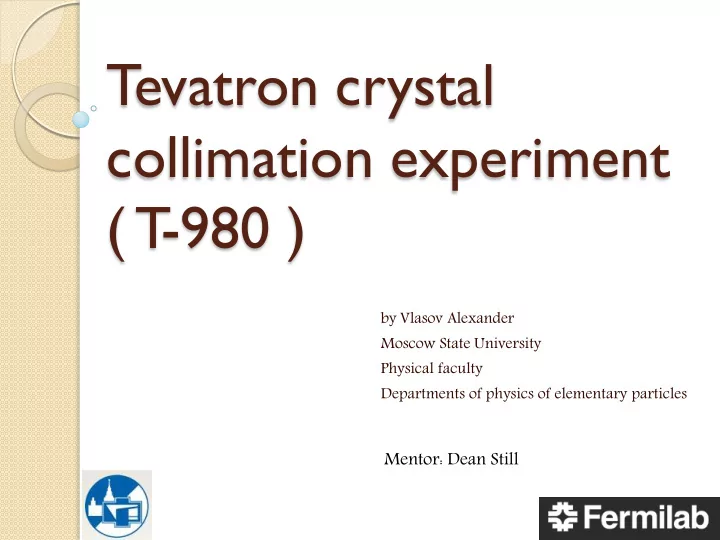

T evatron crystal collimation experiment ( T -980 ) by Vlasov Alexander Moscow State University Physical faculty Departments of physics of elementary particles Mentor: Dean Still
Tevatron crystal collimation experiment New approach to remove beam halo, reducing heat load on cold magnets. Proposed to be used in next LHC collimator upgrade (approximately 2015). Main advantage – can remove beam halo in 1 pass with higher efficiency.
Crystal channeling If particles entering a crystal are properly aligned to the crystal planes, they will follow the planes, even if the crystal is bent.
Other processes in a bent crystal 1. Amorphous orientation 2. Volume reflection 3. De-channeling 4. Volume capture 3 1 4 2
Example of a crystal Multi-strip silicon crystal (16 strips)
System setup – angle scan Angle of crystal in respect to the beam is changed. Crystal goes to “channel” or “volume reflection” mode. Circulating Beam Bent Crystal
Angle scan data and results
Fitting the data Function for fitting: combination of Darwin plateau and a Gaussian. Parameter of a “width” is determined as full width on a half of volume reflection efficiency. Also “sigma” parameter for Gaussian and width of plateau are listed. Efficiency calculated in percents. 100% corresponds to from zero to y0 level.
System setup - collimator scans Collimator is moved to find a distribution of channeled or reflected beam and a displacement between main and channeled/reflected beam Circulating Beam Bent Crystal Collimator
Collimator scan data and results
Fitting the data Depending of a beam profile, different number of Error functions was used. Fitting gives a displacement between channeled/reflected beam and the main beam, so gives a channeling/reflection angle, connected with crystal bend angle. It looks like there are aperture effects between E1 and B0.
Results The data from 2005 till 2010 is analyzed: angle scans and collimator scans. Simulation data was analyzed and showed right choice of fitting functions. Gaussian profile of channeling efficiency vs. angle confirmed. Numerical data for 3 crystals and plots are linked to T- 980 collaboration website.
Experimental results Parameters Crystal O-05-09 MS-08-09 O-BNL-02 Channeling peak -961 (+/- 9 (stat) 655 (+/- 10 (stat) - position, +/- 2 (instr)) +/- 3 (instr)) experimental, urad Channeling peak -963 (+/- 2 (stat) 658.5 (+/- 2.1 - position, +/- 1 (instr)) (stat) +/- 1.3 simulation, urad (instr)) Channeling width, 16 (+/- 5 (stat) 59 (+/- 12 (stat) - experimental, urad +/- 2 (instr)) +/- 3 (instr)) - Channeling width, 10.5 (+/- 1.2 26 (+/- 2 (stat) simulation, urad (stat) +/- 1.1 +/- 1 (instr)) (instr)) Full bend angle, 280 (+/- 54 (stat) 255 (+/- 29 (stat) 444 (+/- 22 (stat) experimental, urad +/- 100 (instr)) +/- 6 (instr)) +/- 108 (instr)) Full bend angle, 360 200 410 (+/- 20) expected, urad
Thank you for attention
Extra slides
Simulation data R-squared 0.999
Recommend
More recommend